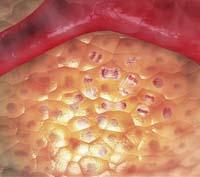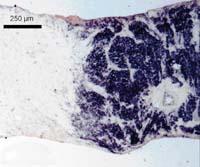Against cancer, fighting metastasis

And why do we say that when cancer spreads in the body there is nothing to do? Initially, a cell becomes malignant and grows uncontrollably, resulting in a primary tumor. At any given time, the cells that make up the tumor grow so much that they leave their original organ and are able to pass into circulation. They can pass into the blood and reach any part of the body.
And why are metastatic cells so deadly? They say that only 1% of cells passing from a primary tumor to circulation are able to produce metastases. In short, these cells are subjected to very high selective pressure and can only thrive in unfavorable conditions.
To begin with, it is a very hard cell capable of getting away from its original organ and moving through the blood. Human blood flows at high speed and its physical-chemical conditions are very inadequate for external cells. And that's just the beginning. If you have been able to overcome this first shock, the next step will be to stop somewhere in the body, and considering the speed at which the blood goes, it is not an easy task. Finally, when he stops in one part of the body, leaves the circulation and passes to another organ, he will have difficulty growing in the place where it has been established, since it is not his organ of origin and for him it is a strange place.
It is clear that a cell that manages to overcome all these obstacles has an enormous capacity to face any problem. And when it gets it, it grows and, in that growth, the surrounding tissues are breaking and the organs lose their functions. Thus, this only cell that has initially overcome growth control could destroy any other organ of the body.

Seed and soil
Metastasis, so explained, is the ability of a cell, once malleted, to expand through the blood to any other organ of the body. But in this process there are more participants. In 1889, the British physician Stephan Paget wrote the theory "Seed and soil". For Paget, each cell causes metastasis in a given organ, that is, each seed likes a concrete (simple) soil.
And that is clear; if we look at the numbers, we will see that colon cancer extends mainly to the liver, the lung to the brain, etc. Closeness is also known to be an important factor, but it has now been shown that the 'dialogue' that occurs between the two in each organ when a particular tumor cell appears is fundamental to the success of metastasis.
A known example is skin cancer. It is known that the cells that form in skin cancer often produce liver metastases, the relationship between these tumor cells and the endothelial cells of liver sinusoids being special. Skin tumor cells have special molecules and other liver endothelial cells, and both types of molecules have a great tendency to associate. Therefore, a cell that is born in the skin and circulates through the blood, can remain in the sinusoid of the liver because of its ability to adhere to it. However, the "dialogue" capacity of the tumor cell with the cells of the organ in which it has been implanted is not limited to mere adhesion, but is only a principle.

Once you have had initial contact, the tumor cell begins to send orders. The cells of the organ where the tumor cell has been stopped and implanted occupy substances that are sent to them by the tumor cell and, in many cases, the signals received by the cells of the receptor organ modify their behavior. In many cases, an inflammatory process occurs in which cytosine, chemokine, H 2 or 2 and other substances appear. Then an 'environment' is created in the receiving organ. This environment is known as tumor microenvironment.
Tumor microenvironment
When the tumor finally gets implanted in another organ, the medium obtained by signals sent to the cells of the receptor organ is only a fertilizer for its survival. For example, the ability of many tumor cells to generate the VEGF factor (Vascular Endotheliall Growth Factor) is well known. This substance produces the growth of the cells that form the veins, so that, over time, after an initial phase without oxygen, the tumor cell generates around it some veins through a process called angiogenesis, which from now on will receive oxygen and nutrients through the blood.
However, when we talk about tumor microenvironment we talk about the inflammatory process. In this process steps are taken in any inflammatory process and substances that extend around the tumor cell are very similar to those that occur in inflammation. In fact, these substances are beneficial for tumor cells, which favors the growth of tumor cells and the appearance of new veins. In short, in this "dialogue" that the tumor cell has started with the cells of the receptor organ, manages to deceive them, creating an inflammatory medium and facilitating the advancement of the tumor.

Metastasis
On the theory of the microenvironment we can learn many things in the fight against metastasis. For example, the survival strategy of tumor cells. In fact, although initially residing in an oxygen-free medium -- after its implantation in another organ and the destruction of its tissues -- they produce long-term veins to facilitate its growth, which is a strategy of tumor survival. Therefore, by cutting this strategy, it can hinder the tumor's ability to grow.
And what medicines can we use? For a molecule that prevents the generation of new veins, for example a molecule that blocks the factor VEGF. The cells that form the veins have special receptors that know the VEGF in their membrane and when joined the VEGF sends signals of cell growth to their interior. If we generate a molecule like VEGF that binds to the receptor but does not generate signal, VEGF will have a competitor and we will reduce the ability to generate new veins. Consequently, the tumor cannot grow so easily.
But things are not that easy. What if we donated this molecule to a woman who has had a menstruation? It would have problems, since after menstruation it is necessary to create new veins. And if a person with heart problems diminished their ability to generate veins with this medicine, wouldn't we endanger their life?

Another strategy to combat metastasis is to reduce the inflammatory medium. And how could we get it? By means of anti-inflammatory drugs. Acetyl salicylic acid is only an anti-inflammatory.
Anticancer drugs
In the world there are thousands of researchers seeking cancer drugs. But will one day get cancer treatment? How long will it take to get it? As US researcher Ishaia Fidler says, "one day we will make cancer a chronic disease, but we must keep in mind that when we use the word cancer we talk about more than 200 diseases." And so it is, there are many types of cancer, any cell in the body has the risk of malignancy, and every cell that is malignant has its own resources.
For example, when they are malignant, a hepatocyte and cutaneous melanocyte do not have the same survival strategy and the chemicals they generate are not the same, so if we want to destroy these cells, the drugs we will design will not be the same either. Each cancer should be treated with a specific medication, with no general response to such a specialized disease.

The same goes for metastasis. Metastasis-causing cells have faced many difficulties. Those who have managed to grow after overcoming all difficulties have suffered a strong selective pressure and a great capacity for life. Therefore, these cells have many strategies to live in the face of any difficulty. If we generate a drug by blocking a specific receptor to stop the growth of a certain cell, this tumor cell will be able to reactivate it through another receptor and will grow as before, so we must cut all its strategies.
Treatment to develop will not only be specific for each type of cancer, but also varied. In short, it is a cocktail of drugs in which each drug cuts a certain tumor cell strategy. If one day we get cancer to end or become chronic with drugs, the key will be the cocktail of drugs, as in other diseases, but always taking into account that each cancer has a specific origin and uses different capacities and resources and that treatments must be specific and not general.
Buletina
Bidali zure helbide elektronikoa eta jaso asteroko buletina zure sarrera-ontzian











